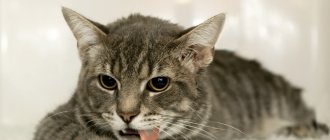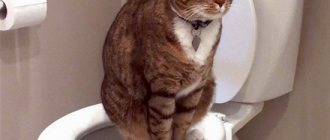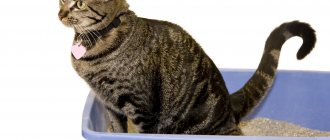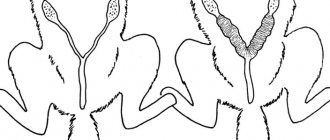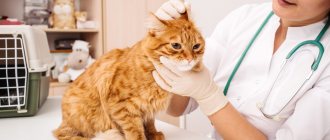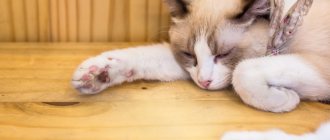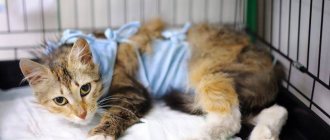Normal cat urination frequency
Cats evolved from the dry, arid regions of Mesopotamia. Water was scarce, so they developed ingenious systems to maintain hydration. As a result, most healthy, adult indoor cats will urinate on average twice a day. How often your cat goes to the toilet will depend on water consumption, heat and humidity, the amount of moisture in the food, as well as medical conditions such as the presence or absence of kidney disease, bladder infections, liver problems, hormonal imbalances and so on.
It is important to know your cat's normal daily urination and bowel habits. Some cats are fine with urinating five times a day, while for others this will signal a sharp increase in potty trips. Many cats only use litter box once or twice a day, and using it four times a day will signal a problem. If your cat suddenly begins to urinate more or less than usual, don't ignore it or put off visiting your veterinarian. Any changes in urination frequency should be checked immediately by your veterinarian.
What does dark color indicate?
If, when cleaning the litter box, it is discovered that the cat’s urine is dark in color, then this phenomenon is a serious cause for alarm. A change in the color of urine towards the dark side is observed in a number of pathologies and can be a symptom of the development of a serious illness in the pet.
| Reasons for dark colored urine | Brief description of the pathology |
| Urolithiasis disease | The most common cause of darkening the color of urine in cats. Urea crystals themselves damage the mucous membrane of the urinary organs. The formation of struvite (stones) in the kidneys and bladder leads to injuries and microbleeding, which is observed in the form of dark-colored urine. Males are most often affected by pathology. If, during inspection of the litter box, the owner notices that the neutered cat has dark urine, the pet should immediately be tested to rule out urolithiasis in the pet. |
| Inflammatory and infectious processes in the genitourinary area | Bacteria and viruses often complicate the course of inflammation in cystitis and urethritis. Often the reason why urine is dark in color is pyelonephritis - a dangerous purulent inflammation in the kidneys. Under the influence of infection, the acidity of urine changes, the permeability of blood vessels increases, which is accompanied by darkening of the urine. Bloody discharge can also occur with such severe diseases of the reproductive system as ovarian cancer, malignant neoplasms in the uterus |
| Infectious and parasitic diseases | Dark color of urine is observed with a dangerous disease for humans and animals - leptospirosis. Microscopic pathogens lead to general intoxication of the body. The urine of a sick cat darkens, sometimes acquiring a brick tint. The dark color of cat urine is also characteristic of many blood-parasitic diseases, for example, piroplasmosis |
| Blood diseases | If the clotting process is disrupted, when platelets are not produced enough, the cat develops a pathological condition - thrombocytopenia. Pathology accompanies diseases such as hepatitis, autoimmune disorders, poisoning, infections |
In addition to serious reasons leading to changes in the organoleptic parameters of feces, a pet may also have physiological ones. For example, in some cats, when estrus occurs, the urine acquires a darker shade, which is not a pathology.
After surgery on an animal, due to a starvation diet and abstinence from food after surgery, urine in the postoperative period also has a rich color. As a rule, 5 to 6 days after surgery, urine parameters also normalize.
Pathologies in urinary frequency
Any increase or decrease in urinary frequency is cause for concern. Decreased frequency of urination, often associated with straining or if the cat makes sounds, can signal a blockage of the urethra and is more common in male cats.
This type of disease can become life-threatening within a few hours. Increased urination can also be associated with bladder infections and cystitis (inflammation), a painful condition. More frequent urination can also be caused by diabetes, kidney disease, and behavioral problems. Visiting the litter box more or less frequently or urinating in unusual places may be the only way your cat can ask you for help. Heed her call as soon as possible.
Diagnosis of diseases
Before contacting the veterinary clinic, the animal should be kept on a fasting diet for 8-12 hours. At the same time, he retains free access to drinking water. The doctor will definitely prescribe not only a urine test, but also a general and biochemical blood test, which is taken on an empty stomach. The absence of food in the stomach and intestines will facilitate an ultrasound examination of the kidneys and bladder. In order not to prolong the diagnosis, you can prepare and collect urine in advance. Pet stores sell special filler that does not absorb liquid. Using a sterile syringe, 30-50 ml of urine is drawn into a special container and delivered to the laboratory within 3 hours. At the first stage, these examinations are enough to determine the amount of drug therapy and the need for surgical intervention.
Abnormal color of cat urine
Cat owners know that the most common change in the color of a cat's urine is darkening or turning red. Often, owners call veterinarians in horror, describing a red trail from the cat's litter box to the food bowl. If you notice any changes in color, especially a red tint to the urine, notify your veterinarian immediately. Our biggest concern is that blood clots, debris such as particulate matter, or swelling due to inflammation or infection can lead to a blockage in the urethra, causing a potentially life-threatening inability to urinate. Urethral blockage can occur within hours, making prompt medical or surgical treatment critical.
Another change to look out for is colorless urine. Pale, watery urine without a healthy golden hue often indicates dilute urine, a sign of kidney disease or diabetes. In general, if the color change is significant enough to be noticed by the naked eye, then it is very important to have your cat diagnosed by a veterinarian.
Safe Reasons
If we consider the normal variant, then the urine of a healthy person should have a yellow color with some straw tint, and there should be no pronounced unpleasant odor. Orange urine appears if the composition changes. However, you need to know that this parameter may be a physiological feature of the body. In this case, you should go to the doctor only when the urine becomes too light or dark.
Orange urine in women and men appears as a result of dehydration. This condition often develops in people who are exposed to increased physical activity. Accordingly, the risk group includes professional athletes who drink little water during training. If there is not enough fluid, the principle of metabolism changes, and related problems begin to develop.
Orange urine in women can have completely harmless causes. A change in the color of biological fluid occurs when consuming certain foods that contain a large amount of coloring pigment. This includes tomatoes, asparagus, carrots, as well as drinks based on them. When you exclude dishes that contain such vegetables from the menu, the urine acquires a normal color.
When orange urine appears, the reasons for women and men may lie in taking certain medications. In this case, specialists will not take this parameter into account when collecting anamnesis, so as not to make an erroneous diagnosis. Among such drugs are those that contain vitamins A and C.
To understand the question of why urine is orange, it is also worth touching on the fact that such a change in the color of biological fluid is typical for morning bowel movements. This is due to the production of a specific hormone in the body, which is produced exclusively during the rest period. It allows a person to sleep fully, without having to wake up at night to empty the bladder.
Every person is well aware that, regardless of what problem he comes to the doctor with, first of all he will be prescribed a general blood and urine test. These biological fluids are quite informative, so they can indicate the presence or absence of problems at the very beginning of diagnosis.
During a laboratory test, a specialist will pay attention to the smell of urine and assess the level of its transparency. Next, you need to determine the daily volume, as well as portions
Particular attention is paid to the composition. The development of diseases is indicated by the presence of protein, glucose, leukocytes and erythrocytes.
Abnormal cat urine odor
Because odor is subjective and many cat owners have developed what we call “olfactory fatigue” when it comes to their litter box, identifying a problematic odor can be a difficult task. Often, even cat carriers have a painfully unpleasant odor. Many foul-smelling urine are associated with bladder infections and cystitis (inflammation of the bladder).
Tumors and hormonal imbalances, especially in male cats, can also cause a sudden change in urine odor. In general, if you smell anything unusual in your cat's litter box, take your cat to the vet.
Symptomatic treatment
To understand the reason for the change in urine color, a specialist will prescribe tests and conduct an ultrasound examination.
Once the diagnosis is established, the veterinarian will prescribe treatment. Most often used:
- antispasmodics;
- anti-inflammatory drugs;
- anthelmintic drugs;
- enzymes and hepatoprotectors;
- antibiotics to remove infectious agents;
- drugs to restore normal intestinal microflora;
- painkillers if the animal is in pain;
- the veterinarian can insert a catheter and flush the bladder;
- herbal remedies, homeopathy to dissolve uric acid salts;
- surgical intervention in the presence of stones or tumors in the kidneys and bladder;
- sterilization and surgery on the genital organs in case of pathologies;
- a strict diet, which in case of irreversible conditions will have to be followed for life.
If the urine suddenly becomes too dark or clear, it is important to monitor how much liquid your cat is drinking. Normally, a healthy cat should consume from 20 to 40 mcg of water per 1 kg of weight
During the hot season, the amount of fluid consumed increases
Normally, a healthy cat should consume from 20 to 40 mcg of water per 1 kg of weight. During the hot season, the amount of fluid consumed increases.
If a cat is hot, it can lose a large amount of moisture through its skin. Therefore, this loss must be replenished and clean, fresh water offered to your pet as often as possible.
By the way, neither cats nor people should be offered distilled water, which does not contain mineral salts, for drinking. Such water is not retained in the body.
You also need to carefully ensure that the cat does not drink water from the aquarium, toilet, or from puddles outside. The flora of the aquarium is quite specific, and the animal can easily catch an infection. And the water in the toilet and puddles is completely unsuitable for drinking, which is obvious.
If the animal has been prescribed treatment, and the disease is associated with pathology of the kidneys or bladder, then the cat should drink a lot. You need to make sure that the drinking bowl is not too narrow and is in its usual place.
If your pet refuses to drink on its own, you can periodically pour water into its mouth using a syringe, or pour water into a large bucket or basin that the cat will approach “in between times.”
During the treatment period, it is necessary to exclude dangerous foods: raw meat and fish, dry food. Also, you should not give your cat foods that can cause allergies (chocolate, tomatoes, citrus and others).
Changes in your cat's urine are serious.
The bottom line is that the definition of cat urine as normal or based on what is typical for your kitten. Because a cat's lower urinary tract is extremely susceptible to infection, inflammation, and is a marker of kidney problems, diabetes, and other diseases, monitor closely for any changes in the frequency, color, or odor of the urine. We often tell pet owners that even subtle changes can be significant, and this is uniquely true with cat urination. If your cat has abnormal urine, simple blood and urine tests can quickly inform your veterinarian about the appropriate diagnosis, treatment, and prognosis. If the issue is addressed as quickly as possible, most causes of abnormal urine in cats can be corrected, and your cat will be feeling good in no time.
If you have any questions or concerns, you can always visit or call our veterinarian - your best resource for ensuring the health and well-being of your pets.
Treatment of diseases: options and approaches
Depending on the illness that caused the change in the color of the urine, the fluffy is prescribed a set of medications.
If a pathology is diagnosed, the veterinarian will prescribe the pet a strict diet and drinking regime. To treat inflammatory processes in the kidneys, antispasmodics and uroseptics are prescribed. With urolithiasis, there is a possibility of surgery to remove the stone from the urinary tract if it is too large. Infectious diseases are treated with antibiotics, and parasitic infestations and blood diseases can be treated with specific medications.
It is important to remember that self-medication is dangerous, and seeking specialized help as soon as possible increases the likelihood of your pet’s recovery.
How to determine color?
This confuses many owners. Indeed, if a pet relieves itself in the garden, then the task is almost impossible. But if you see that your pet has become boring, then you need to try to keep an eye on him. It's not that difficult. If the animal is really sick, it will not go far. Surely the cat will empty its bladder near the nearest post and return home. It is much easier if the animal is trained to relieve itself in the tray. Then leave it empty once, without filler, and evaluate the collected material.
What will you need to pay attention to? The urine of a healthy cat is yellowish, but not rich in color. Urobilin gives urine its straw color. It is removed from the body in this way so as not to affect the animal’s nervous system. Dark urine in a cat, or bright yellow, rich urine, indicates health problems.
